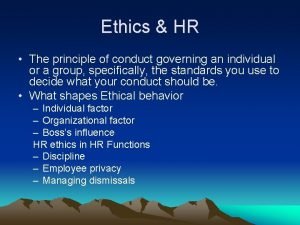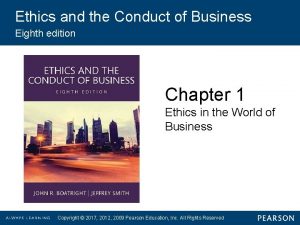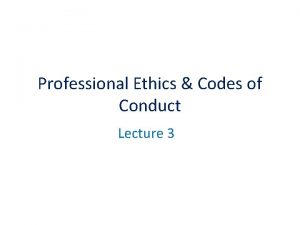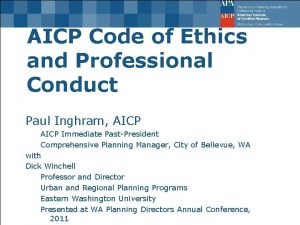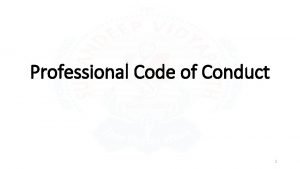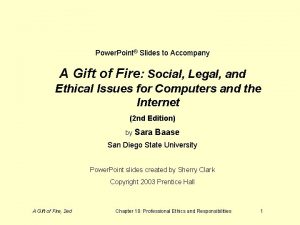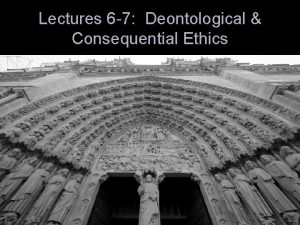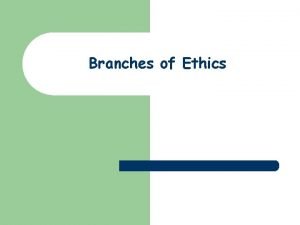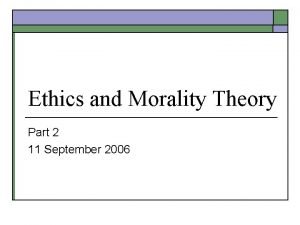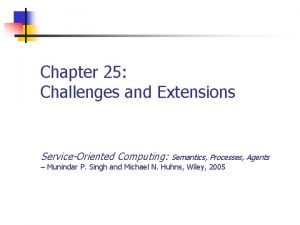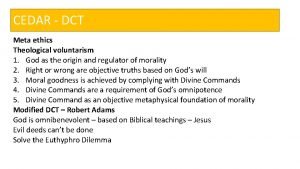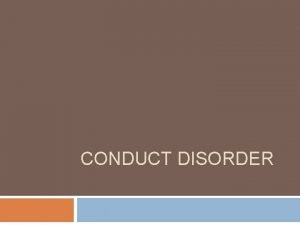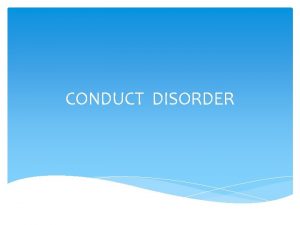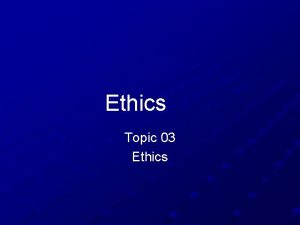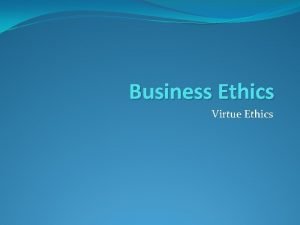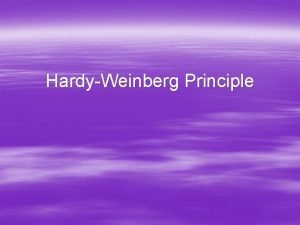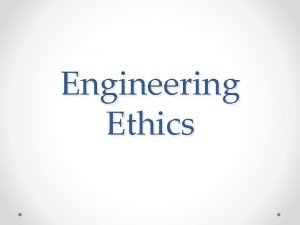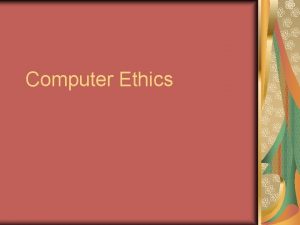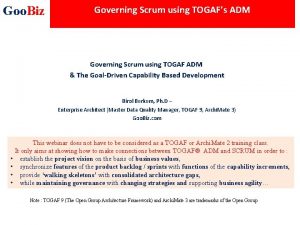Ethics HR The principle of conduct governing an














- Slides: 14

Ethics & HR • The principle of conduct governing an individual or a group, specifically, the standards you use to decide what your conduct should be. • What shapes Ethical behavior – Individual factor – Organizational factor – Boss’s influence HR ethics in HR Functions – Discipline – Employee privacy – Managing dismissals

Labor unions • • Why do workers need union What unions wants? – Union security – Wages, salaries, hours, working conditions • • Collective bargain…management and labor representative meet to reach a labor settlement Weapons labor unions and management use Corporate campaigns… where unions mobilize other company unions to pressurize the employer like officer union, teacher union, staff union. Boycott… the combined refusal of employees and others interested to work or use company resources. Inside games… unions influence by convincing to impede or slow down the pace of work Lockout… a refusal by the employer to permit the working opportunities Injunction… a court order compelling a party or both to diffuse or work

Bargain on issues • • • Impasse… a blockade in a situation or negotiation Mediation… a third party interferences to resolve Fact finder… third party finds the problems neutrally Arbitration… where a third party resolve with authority to decide or influence Types of strike Strike… a withdrawal of labor Economic strike… a strike that evolves because of the failure to agree on the terms of employment contract Unfair labor practice strike… a strike aimed at protesting illegal conduct by the employer Wildcat strike… an unauthorized strike occurring during the term of a contract Sympathy strike… a strike occur in support of another strike Picketing… employees carrying signs announcing their concern near the employers place of business

Grievances • Any factor involving wages, hours or conditions of employment that is used as a complaint against the employer

Health, Safety and ISO Certification • Occupational safety and health act (osha) • Occupational illness • Any abnormal condition or disorder caused by exposure to environmental factors associated with employment • Inspection & citation… government summons the employer and employees to inform about the laws violation

What causes accidents? • Unsafe conditions… are the main cause – – – • Workplace health hazards – – – – • Improper guarded equipment Defective equipment Hazardous in, or around machines or equipment Unsafe storage… congestion and overloading Improper illumination… glare, insufficient light Improper ventilation… insufficient air change, impure air source Chemical and hazardous materials Excessive noise and vibrations Temperature extremes Biohazards Ergonomics hazard (poor design of equipment) Slippery floors and blocked passageway Smoking Violence at work Security – Work place and equipment and personnel

ISO • ISO (International Organization for Standardization) is the world's largest developer and publisher of International Standards. • ISO is a network of the national standards institutes of 157 countries, one member per country, with a Central Secretariat in Geneva, Switzerland, that coordinates the system. • ISO is a non-governmental organization that forms a bridge between the public and private sectors. On the one hand, many of its member institutes are part of the governmental structure of their countries, or are mandated by their government. On the other hand, other members have their roots uniquely in the private sector, having been set up by national partnerships of industry associations. • Therefore, ISO enables a consensus to be reached on solutions that meet both the requirements of business and the broader needs of society

ISO 9000 • • ISO 9000 is a family of standards for quality management systems. ISO 9000 is maintained by ISO, the International Organization for Standardization and is administered by accreditation and certification bodies. Some of the requirements in ISO 9001 (which is one of the standards in the ISO 9000 family) include a set of procedures that cover all key processes in the business; monitoring processes to ensure they are effective; keeping adequate records; checking output for defects, with appropriate and corrective action where necessary; regularly reviewing individual processes and the quality system itself for effectiveness; and facilitating continual improvement A company or organization that has been independently audited and certified to be in conformance with ISO 9001 may publicly state that it is "ISO 9001 certified" or "ISO 9001 registered". Certification to an ISO 9000 standard does not guarantee any quality of end products and services; rather, it certifies that formalized business processes are being applied. Indeed, some companies enter the ISO 9001 certification as a marketing tool.

• • ISO 9000 family ISO 9000 includes standards: ISO 9000: 2000, Quality management systems – Fundamentals and vocabulary. Covers the basics of what quality management systems are and also contains the core language of the ISO 9000 series of standards. A guidance document, not used for certification purposes, but important reference document to understand terms and vocabulary related to quality management systems. In the year 2005, revised ISO 9000: 2005 standard has been published, so it is now advised to refer to ISO 9000: 2005. ISO 9001: 2000 Quality management systems – Requirements is intended for use in any organization which designs, develops, manufactures, installs and/or services any product or provides any form of service. It provides a number of requirements which an organization needs to fulfill if it is to achieve customer satisfaction through consistent products and services which meet customer expectations. It includes a requirement for the continual (i. e. planned) improvement of the Quality Management System, for which ISO 9004: 2000 provides many hints. This is the only implementation for which third-party auditors may grant certification. It should be noted that certification is not described as any of the 'needs' of an organization as a driver for using ISO 9001 (see ISO 9001: 2000 section 1 'Scope') but does recognize that it may be used for such a purpose (see ISO 9001: 2000 section 0. 1 'Introduction'). ISO 9004: 2000 Quality management systems - Guidelines for performance improvements. covers continual improvement. This gives you advice on what you could do to enhance a mature system. This standard very specifically states that it is not intended as a guide to implementation. There are many more standards in the ISO 9001 family (see "List of ISO 9000 standards" from ISO), many of them not even carrying "ISO 900 x" numbers. For example, some standards in the 10, 000 range are considered part of the 9000 family: ISO 10007: 1995 discusses Configuration management, which for most organizations is just one element of a complete management system. ISO notes: "The emphasis on certification tends to overshadow the fact that there is an entire family of ISO 9000 standards. . . Organizations stand to obtain the greatest value when the standards in the new core series are used in an integrated manner, both with each other and with the other standards making up the ISO 9000 family as a whole". Note that the previous members of the ISO 9000 family, 9001, 9002 and 9003, have all been integrated into 9001. In most cases, an organization claiming to be "ISO 9000 registered" is referring to ISO 9001.

ISO 10006 • ISO 10006: 2003, Quality management systems - Guidelines for quality management in projects, is an international standard developed by the International Organization for Standardization. • ISO 10006: 2003 gives guidance on the application of quality management in projects. • It is applicable to projects of varying complexity, small or large, of short or long duration, in different environments, and irrespective of the kind of product or process involved. This can necessitate some tailoring of the guidance to suit a particular project. • ISO 10006: 2003 is not a guide to "project management" itself. Guidance on quality in project management processes is discussed in this International Standard. Guidance on quality in a project's product-related processes, and on the "process approach", is covered in ISO 9004. A new "Project Management - Guide to project Management" ISO 21500 is in preparation (2008). • Since ISO 10006: 2003 is a guidance document, it is not intended to be used for certification/registration purposes

ISO 14000 • • • The ISO 14000 environmental management standards exist to help organizations minimize how their operations negatively affect the environment (cause adverse changes to air, water, or land) and comply with applicable laws and regulations. ISO 14001 is the international specification for an environmental management system (EMS). It specifies requirements for establishing an environmental policy, determining environmental aspects and impacts of products/activities/services, planning environmental objectives and measurable targets, implementation and operation of programs to meet objectives and targets, checking and corrective action, and management review. ISO 14000 is similar to ISO 9000 quality management in that both pertain to the process (the comprehensive outcome of how a product is produced) rather than to the product itself. The overall idea is to establish an organized approach to systematically reduce the impact of the environmental aspects which an organization can control. Effective tools for the analysis of environmental aspects of an organization and for the generation of options for improvement are provided by the concept of Cleaner Production. As with ISO 9000, certification is performed by third-party organizations rather than being awarded by ISO directly. The ISO 19011 audit standard applies when auditing for both 9000 and 14000 compliance at once.

• • • • Standards The material included in this family of specifications is very broad. The major parts of ISO 14000 are: ISO 14001 is the standard against which organizations are assessed. ISO 14001 is generic and flexible enough to apply to any organization producing and/or manufacturing any product, or even providing a service anywhere in the world. ISO 14004 is a guidance document that explains the 14001 requirements in more detail. These present a structured approach to setting environmental objectives and targets and to establishing and monitoring operational controls. These are further expanded upon by the following: ISO 14020 series (14020 to 14025), Environmental Labeling, covers labels and declarations. ISO 14030 discusses post-production environmental assessment. ISO 14031 Evaluation of Environmental Performance. ISO 14040 series (14040 to 14044), Life Cycle Assessment, LCA, discusses pre-production planning and environment goal setting. ISO 14050 terms and definitions. ISO 14062 discusses making improvements to environmental impact goals. ISO 14063 is an addendum to 14020, discussing further communications on environmental impact. is Greenhouse gases – Part 1: Specification with guidance at the organization level for the description, quantification and reporting of greenhouse gas emissions and removals. is Greenhouse gases – Part 2: Specification with guidance at the project level for the description, quantification, monitoring and reporting of greenhouse gas emission reductions and removal enhancements. is Greenhouse gases – Part 3: Specification with guidance for the validation and verification of greenhouse gas assertion. ISO 19011 which specifies one audit protocol for both 14000 and 9000 series standards together. This replaces ISO 14011 meta-evaluation—how to tell if your intended regulatory tools worked. 19011 is now the only recommended way to determine this.

ISO 19011 • ISO 19011 is an international standard that sets forth guidelines for: • quality management systems auditing • environmental management systems auditing • It is developed by the International Organization for Standardization. • The standard offers four resources to organizations to "save time, effort and money": • A clear explanation of the principles of management systems auditing. • Guidance on the management of audit programmes. • Guidance on the conduct of internal or external audits. • Advice on the competence and evaluation of auditors.

ISO 27000 • ISO/IEC 27000 • (Redirected from ISO 27000) ISO/IEC 27000 part of a growing family of ISO/IEC ISMS standards, the 'ISO/IEC 27000 series' is the number reserved for a new international standard, which currently has the provisional title: "Information technology - Security techniques - Information security management systems - Overview and vocabulary". The standard is known informally as "ISO 27000". • The standard is being developed by a sub-committee of the Joint Technical Committee (JTC 1) of the International Organization for Standardization and the International Electro technical Commission. • ISO 27000 will provide an overview of standards related to the ISO/IEC 27000 Information Security Management Systems (ISMS) family of standards and provide uniformity and consistency of fundamental terms and definitions (vocabulary) used throughout the ISMS family. • Information security, like many technical subjects, is evolving a complex web of terminology. Relatively few authors take the trouble to define precisely what they mean, an approach which is unacceptable in the standards arena as it potentially leads to confusion and devalues formal assessment and certification. As with ISO 9000 and ISO 14000, the base '000' standard is intended to address this.
 The principles of conduct governing an individual or
The principles of conduct governing an individual or Ethics and the conduct of business
Ethics and the conduct of business Acm code of ethics and professional conduct
Acm code of ethics and professional conduct Aicp code of ethics and professional conduct
Aicp code of ethics and professional conduct Code of conduct professional ethics
Code of conduct professional ethics Cips code of ethics and professional conduct
Cips code of ethics and professional conduct Deontological ethics definition
Deontological ethics definition Meta ethics
Meta ethics Descriptive ethics vs normative ethics
Descriptive ethics vs normative ethics Descriptive ethics vs normative ethics
Descriptive ethics vs normative ethics Teleological ethics vs deontological ethics
Teleological ethics vs deontological ethics Macro and micro ethics
Macro and micro ethics Compensatory justice examples
Compensatory justice examples 6075 meaning
6075 meaning Metaethics vs normative ethics
Metaethics vs normative ethics
